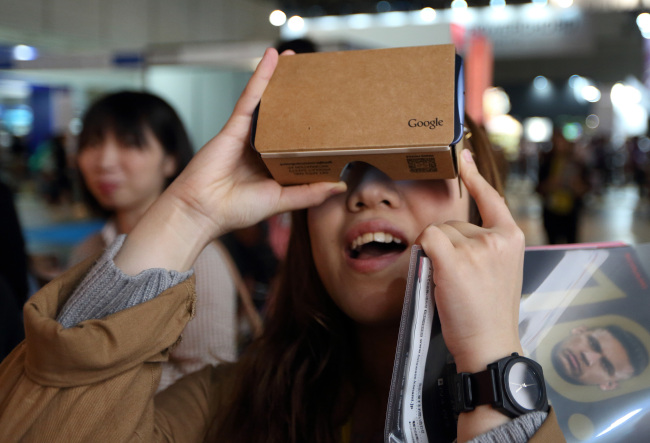[Weekender] Tech giants dive into virtual reality race
Games, entertainment lead VR growth
By Kim Young-wonPublished : Jan. 29, 2016 - 17:59
Odds are you may think that virtual reality was developed in recent years.
But it has long existed in different forms, arguably stretching back to the 360-degree murals of the 19th century and the stereoscope View-Master made in 1939.
The term virtual reality is said to have been coined in the mid-1900s and augmented reality, which overlays 3-D images over the real world, came along in the 1950s.
But it has long existed in different forms, arguably stretching back to the 360-degree murals of the 19th century and the stereoscope View-Master made in 1939.
The term virtual reality is said to have been coined in the mid-1900s and augmented reality, which overlays 3-D images over the real world, came along in the 1950s.

History aside, virtual and augmented reality are now prompting changes in many industries, including gaming, movie, medicine and even pornography.
Reflecting its perceived potential, money is being funneled into the virtual technology with global tech heavyweights competitively acquiring and investing in promising start-ups in the VAR sector.
Most notably, social networking giant Facebook acquired Oculus VR for $2 billion in early 2014, followed by a $540 million funding led by Google and Qualcomm for California-based AR start-up Magic Leap in October of the same year.
Apple bought Metaio, whose technology overlays digital images on top of a real-world screen in May last year while Samsung Electronics’ investment arm Samsung Ventures has invested in FOVE, a developer of an eye-tracking headset, which allows users to control VR applications by simply looking in different directions.
Samsung also teamed up with Oculus VR to roll out its head-mounted display, dubbed the Gear VR, late last year.
The latest Gear VR, a scaled-down version of the initial Gear VR for developers, released in late 2014, wowed attendees at the CES electronics trade show held earlier this month in Las Vegas.
The Seoul-headquartered electronics giant ran a large-scale hands-on experience zone where visitors could dive into a virtual world while sitting in a moving chair with the Gear VR on.
LG Electronics’ own VR glasses are also in the pipeline -- the firm has filed a patent for them in Korea -- while mobile carrier SK Telecom has teamed up with Google to incorporate its augmented reality solution T-AR into the U.S. Internet giant’s Project Tango platform, aimed at giving mobile devices a sense of space.

Hardware-wise, there is no technical gap between Silicon Valley-based VR companies and Seoul-based ICT firms, but experts said that, on the software front, the domestic players are a couple of years behind their Silicon Valley counterparts.
“Silicon Valley firms are armed with unmatchable capability in software platforms, such as Unity, a software development tool widely used when making VR content,” said Jeong Ji-hoon, a professor of Kyung Hee Cyber University and an outside director of digital broadcasting software developer Alticast.
“The domestic firms will struggle to catch up with global tech firms like Facebook and Google, both of which boast great market power, in the VR content platform market.”
Dan Cryan, an analyst from market research firm IHS, said in a report that around 7 million VR headsets would be shipped by the end of 2016, and the consumer virtual reality headset market, recently buoyed by a series of new VR products, including Sony PlayStation VR, Oculus Rift, Samsung Gear VR, and HTC Vive, will reach $2.6 billion by 2020.
Businesses that are first in line to adopt the VAR technology are those for the so-called “3S’s,” according to Choi Jae-hong, a multimedia engineering professor from Gangneung-Wonju National University.
“The 3S’s -- sex, screen, and sport -- are expected to be the first segments to deploy the VAR technology, followed by lifestyle, education, and health in that order,” professor Choi said.
Choi also anticipated that dominant application platforms for VAR gadgets -- like Google’s Android or Apple’s iOS app markets -- will soon emerge.
“The virtual reality market will become as big as the Internet of Things segment in the future,” he said.
Experts said, however, in order for the virtual technology to go mainstream, VR players need to work on improving their user experience, including picture quality, minimizing possible health risks, especially those on a viewer’s eyes and brain due to the long usage of the devices, and creating content platforms.
“Large VR firms are well aware of the importance of creating an ecosystem for content creators, so competition (to lead the VR platform sector) will also heat up in the coming years,” professor Jeong said.
By Kim Young-won (wone0102@heraldcorp.com)





![[Herald Interview] Mom’s Touch seeks to replicate success in Japan](http://res.heraldm.com/phpwas/restmb_idxmake.php?idx=644&simg=/content/image/2024/04/29/20240429050568_0.jpg&u=)




![[News Focus] Lee tells Yoon that he has governed without political dialogue](http://res.heraldm.com/phpwas/restmb_idxmake.php?idx=644&simg=/content/image/2024/04/29/20240429050696_0.jpg&u=20240429210658)







![[Today’s K-pop] Seventeen sets sales record with best-of album](http://res.heraldm.com/phpwas/restmb_idxmake.php?idx=642&simg=/content/image/2024/04/30/20240430050818_0.jpg&u=)